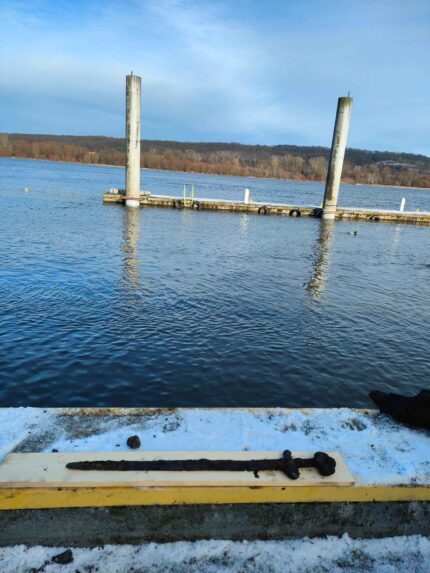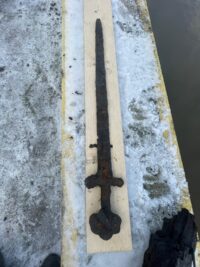 A Viking-era sword bearing an Ulfberht inscription was discovered last week during dredging works on the Wisła river in Włocławek, central Poland. The sword is more than a thousand years old. Even heavily encrusted and blackened by years spent at the bottom of a silty river, the three lobes of the pommel are clearly discernible, categorizing it as a Petersen Type S sword which typically date to the 10th century.
A Viking-era sword bearing an Ulfberht inscription was discovered last week during dredging works on the Wisła river in Włocławek, central Poland. The sword is more than a thousand years old. Even heavily encrusted and blackened by years spent at the bottom of a silty river, the three lobes of the pommel are clearly discernible, categorizing it as a Petersen Type S sword which typically date to the 10th century.
The sword was found by workers removing the alluvial sediment that had built up on the floor of the marina basin. An oblong metal object was spotted in the pile of extracted sediment and a quick rinse revealed it to be a sword. An X-ray of the sword found the inscription “+VLFBERHT+” on the blade.
There are about 170 Ulfberht swords known. Characterized by the inscription +VLFBERHT+ or +VLFBERH+T on the blade, because “Ulfberht” is a Frankish name, the swords are believed to be of Frankish origin, likely from the Rhineland region. They were manufactured from the 9th to the 11th centuries using a variety of metalworking techniques. Most of them have been found in Northern Europe, Russia and the Baltic states. Only eight of them have been found in Poland.
 Petersen Type S swords were often covered in organic materials like leather or rope at the hilt, materials that could very well have survived the centuries in the anaerobic conditions of the river sediment. The Provincial Office for the Protection of Monuments has delivered the sword to researchers from the Nicolaus Copernicus University who will study, clean and conserve it. Once it has been conserved, it will become a permanent addition to the collections of the Museum of the Kuyavian and Dobrzyń Lands, and will go on display at the Włocławek History Museum.
Petersen Type S swords were often covered in organic materials like leather or rope at the hilt, materials that could very well have survived the centuries in the anaerobic conditions of the river sediment. The Provincial Office for the Protection of Monuments has delivered the sword to researchers from the Nicolaus Copernicus University who will study, clean and conserve it. Once it has been conserved, it will become a permanent addition to the collections of the Museum of the Kuyavian and Dobrzyń Lands, and will go on display at the Włocławek History Museum.